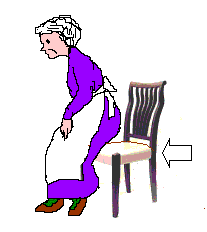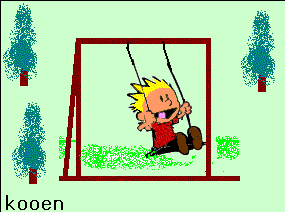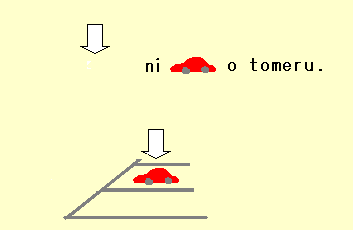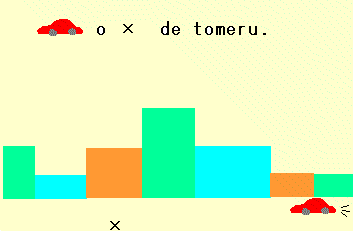Japanese
* JAPNESE HOME PAGE IS HERE
NI and DE
This monthfs lesson is about the particles Ni and De.

1. The particle Ni is used:
(1) to indicate the place where a thing(s) or a person(s) is(or are) present.
- 1 Gakkoo ni ookii puuru ga aru. ( There is a big swimming pool in our school.)
- 2 Doa no soba ni hito ga tatte iru. (There is a man standing at the door.)
- 3 Hon wa kaban ni haitte iru. (The book is in the bag.)
- 4 Gakkoo ni amerikajin no sensee ga iru. (There is an American teacher at our school.)
- 5 Kabe ni e ga kakatte iru. (There is a picture on the wall.)
- 6 Tana ni tokee ga oite aru. ( There is a clock on the shelf.)
(2) to mark one's goal or destination.

- 1 Watashi wa mainichi kaisha ni iku. ( I go to the office every day.)
- 2 Kyoo wa hayaku ie ni kaetta. ( I came home early today.)
- 3 Gomi ni karasu ga atsumatte iru. (There are crows flocking into the garbage.)
- 4 Haha ni purezento o ageru. (I give a present to Mother.)
- 5 Obaasan ga isu ni suwaru. (An old woman sits on a chair. )
- 6 Nooto ni ji o kaku. ( I write in my notebook.)
2. The particle De is used to indicate the place where an action occurs.
- 1 Toshokan de hon o yonda. ( I read books at a library.)

- 2 Kissaten de tomodachi ni au. ( I meet a friend of mine at a coffee shop.)
- 3 Gakkoo de benkyoosuru. ( I study at school.)
- 4 Kodomo ga kooen de asonde iru. ( Kids are playing in a park.)
- 5 Kinoo ie no kinjo de kaji ga atta. (There was a fire near my house yesterday.)
- 6 Asu gakkoo de undookai ga aru. (We'll have a field day at school tomorrow.)
Note that atta in #5 and aru in #6 do not mean the existence nor presence, but
mean 'an accident happens' and 'an event is held' respectively.
3. As you see in 1.and 2. above, Ni casts the sight upon a place, while De upon an action.
(F=false R=right)
(1)
(R) Eki ni saifu o wasureta.
( I forgot my wallet at the station.)
Speaker's sight is upon a place ( the station).
(R) Eki de saifu o wasureta. ( ditto in translation)
Speaker's sight is upon an action (wasureta.)
As mentioned above De casts the sight upon an action, De needs space
where an action is taken. Now you can say which is a correct Japanese expression for 'I forgot my wallet on a bench at the station.'

(R) Eki no benchi ni saifu o wasureta.
(F) Eki no benchi de saifu o wasureta.
(2)
(R) Kuruma wa 10ban ni tomete kudasai. (Please park your car in #10.)
(F) Kuruma wa 10ban de tomete kudasai.
(R) Asoko no kado de tomete kudasai (Please stop at that corner.)
(F) Asoko no kado ni tomete kudasai.
As Ni casts the sight upon a place, tomeru means to park.
And as De casts the sight upon an action, tomeru means to stop.
4.The following are the expressions you should memorize exactly.

- 1 Kaisha ni tsutomeru. (I work at the office.)j
- 2 Kaisha de hataraku. ( I work in the office.)
- Tsutomeru is always with ni while hataraku is with de.
- 3 Umi no soba ni sumitai. ( I want to live by the sea.)
- 4 Oosaka ni tomaru. ( I stay a night in Osaka.)
- 5 Oosaka de hoteru ni tomaru. ( I stay a night at a hotel in Osaka.)
We are expert Japanese teachers. We are confident that this article is good
and useful for foreign learners of Japanese. But we are afraid our English is
not so good. When you find any spelling or grammatical mistakes,
please let us know.
We also offer private lessons for students of all levels.
For more information , please e-mail us.
EMAIL: o1779uma@ca2.so-net.ne.jp
 /// JAPAN CULTURE STUDY GROUP ///
/// JAPAN CULTURE STUDY GROUP ///
RETURN TO COVER






 /// JAPAN CULTURE STUDY GROUP ///
/// JAPAN CULTURE STUDY GROUP ///